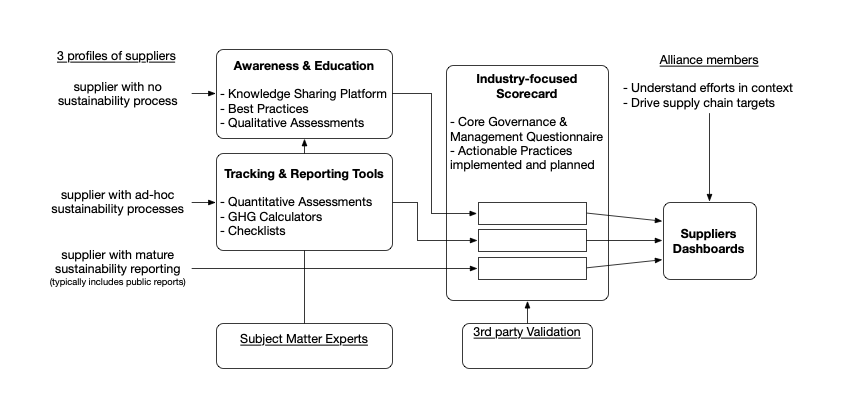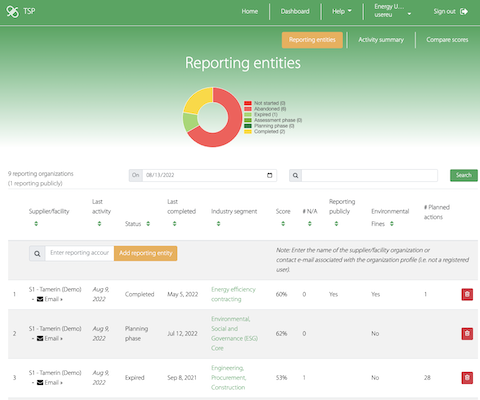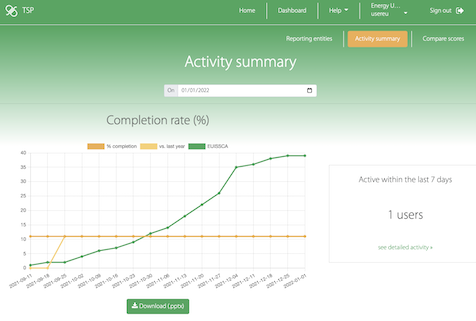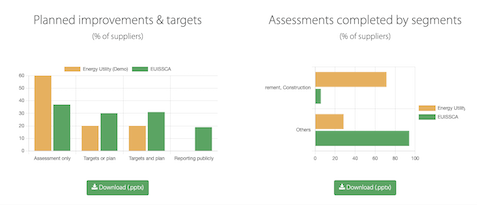ESG/Environmental practices

By taking this questionnaire, an organization can:
- Assess their environmental, social and governance policies against best practices
- Improve their sustainability initiatives
- Share reports with investors, customers and other stakeholders
(Free)
TSP ESG/Environmental practices questionnaire was designed, and is regularly updated, through a consensus building process that involves the many stakeholders to make a supply chain sustainability program successful.
Special thanks to the following contributors!


Structure of the ESG/Environmental practices questionnaire
The ESG/Environmental practices questionnaire is composed of a set of ESG policies core questions typically used as the basis for sustainability scoring within a bid or request for proposal (RFP) process, and an optional set of industry-focused environmental practices suited to implement actionable steps that will improve the organization sustainability posture.
ESG Core Questions
Through practices widely implemented and industry reporting frameworks (e.g. CDP, GRI, SASB/ISSB), core questions are identified. These questions are used as the backbone of sustainability request for proposal/information (RFP/RFI) questionnaires and supplier environmental, social, and governance (ESG) scorecarding.
A core question must fulfill the following criteria.
- The question is mapped to one or more reporting framework (e.g. CDP, GRI, SASB/ISSB).
- An answer to the question can be validated by a 3rd party through a set of specified documentation.
- A negative answer can be remedied by setting a concrete target and improvement plan.
There are currently 25 core questions. While an organization can optionally add one or multiple practices industry segments to its assessment, the core questions must be answered before an assessment is completed.
The ESG core questions are subdivided into sections about governance & management, data & metrics, and targets.
Governance & management topics
These are Yes/no core questions. In order to answer yes, an organization must have processes and documentation in place to support that answer. Documentation can be validated by third-parties following the criteria found in the question extended description.
Data & metrics
The sustainability assessment contains a section to report Energy, GHG Emissions, Water and Waste data metrics.
If you readily have that data, you can enter it directly. Otherwise there are tools under the Tracking section on TSP to to track your organization's energy, water and waste metrics and estimate Green House Gas (GHG) emissions.
Targets
This section contains free form text fields, baseline and horizon dates to describe Energy use, GHG Emissions reduction, Water use and Waste reduction targets.
Supporting plans to hit those targets must be provided. TSP provides tools to create an improvement plan when you add an industry segment practices section to an assessment.
Industry Practices
Through experience industry best practices emerge. A practice must fulfill the following criteria.
- There must be a body of knowledge to support the practice.
- The practice's intrinsic Environmental value, Ops/maintenance value, Financial value, and implementation ease can be assessed qualitatively.
- The practice's impact in terms of Energy & Green House Gas (GHG) Emissions, Water or Waste can be measured, or can lead to more accurate measurements.
- The value of the practice to one or more industry segments can be demonstrated.
There are currently 400+ environmental sustainability practices covering 24 industries segments on TSP. They form the basis of a rigorous sustainability assessment of an organization.
- 28 category tiles
- 405 environmental sustainability practices
- 24 industries segments
How were questions and practices identified and selected?
TSP partners with industry stakeholders and with subject matter experts in best practice focus areas to develop and update content.
Over the years, a body of knowledge accumulates through informal conversations, conferences, presentations of trial-and-learn experiments, etc. This website was designed to capture this raw knowledge through an informal wiki-style Knowledge Sharing section. Through the raw knowledge, patterns emerge.
ESG core questions and environmental practices are selected through a transparent and inclusive content governance process and are updated regularly.
TSP’s mission is to provide universal access to supplier relationship management best practices. As such questionnaires and knowledge bases directly developed through TSP content governance process are made available under a Creative Commons License (i.e. CC BY-SA to be exact).
How does it work?
For suppliers
Assess
Assess maturity relative to best practices and benchmark with industry peers.
Improve
Select improvement actions on a value-ranked basis and see impact on scores & benchmark position.
Report
Share scorecard with clients at your discretion. Use outputs for in/external reports.
For procurement & supply chain relationship managers
Meet your suppliers where they are.
You have identified your organization's 80% spend, or made a list of tier 1 suppliers by risk and/or impact. It is time to send them an initial survey.
Suppliers will be at different steps in their sustainability journey. TSP was specifically designed for:
- Mature organizations to report their progress against standardized questions.
- Progressing organizations to find the tools (GHG Calculators, etc.) to track and improve data & metrics related to energy and water use vs. GHG emissions and waste generated.
- Starting organizations to learn, assess their practices against peers and create a baseline to improve upon.

Track engagement and chart responses
1. Invite suppliers and colleagues
You can invite as many suppliers as you wish. Suppliers that have already answered the assessment previously can share their response with you with a single click.
You can invite as many colleagues as you want to see your organization dashboard. If the need arises to connect your organization's Active Directory and Single Sign-On (SSO) login workflow with TSP, our support team can configure this so you have full control of the authentication workflow for your users.

2. Track engagement
TSP sends automatic reminders to suppliers that haven't completed the assessment within the allocated time period.
You can track individual supplier activity as well as aggregate of your suppliers completion rate vs. last year vs. your industry peers.

3. Start a dialogue around sustainability with suppliers
TSP gives you insight in suppliers that have set sustainability targets and/or have improvement plans in place, segmented by industry. Furthermore through membership into an Alliance and TSP unique aggregated anonymous datasets you will be able to compare how your suppliers stack against suppliers in the Alliance as a whole.
At every step, suppliers are encouraged to share practices they implement and targets they set for themselves. TSP is uniquely designed to capture knowledge and share it within a broader community.
At every step, we have real knowledgeable humans to support you. For any questions, comments or general feedback, always feel free to contact us.

Contact us“If you want to go fast, go alone. If you want to go far, go together.”